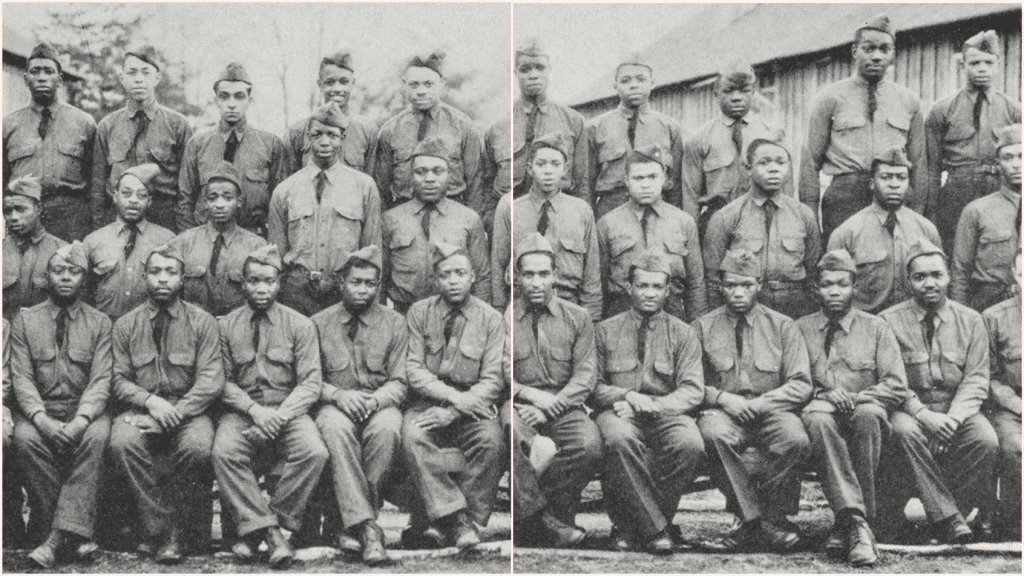

Members of Company 1360 of the Civilian Conservation Corps. Photo credit coming soon.
I recently reported on the Norfolk Botanical Garden researching and celebrating the African American workers who built it as part of FDR’s New Deal. Now I’m thinking that may be part of a growing national movement toward long-overdo acknowledgements because the National Arboretum has accomplished something similar.

Company 1360 workers at what’s now the National Arboretum.
Like the Norfolk garden’s recognition of its WPA workers, the Arboretum has uncovered and celebrates its first workers – the 300+ young African-American men employed to work there by the Civilian Conservation Corps (CCC).
FDR initiated the CCC, a public works program, to address the problem of high unemployment among young men during the Great Depression. It ultimately hired over 2.5 million people before its conclusion in 1942.
What these CCC workers accomplished
The all-African-American Company 1360 unit of the CCC was located in Camp NA-1 on the grounds of what’s now the Arboretum. Highlights of the work they performed there from 1934 to 1941 include: almost eight miles of roads, six bridges, many hundreds of acres cleared of brush and invasives, more than 9.5 miles worth of drainage tile installed, extensive excavating and grading, three ponds, five pit houses, and a complete perimeter fence.
As Arboretum director Richard Olsen wrote in a press release, “When Company 1360 arrived at the Arboretum, the land was a patchwork of small farms, a lot of overgrowth, abandoned and dilapidated structures, and no effective way to travel across the terrain. When they left, the Arboretum looked like something that merited the name.”
CCC enrollees earned $30 a month, at least $22 of which was required to be sent home to dependent family members. Housing, food, medical care, and clothing were provided for them. In return, CCC workers developed and protected America’s natural resources, working in parks, forests, and other natural settings.
Camp NA-1 eventually closed in 1941 due to the Army’s need to establish wartime defenses of the capital.
Another example of segregation?
Because the black workers who built the Norfolk Botanical Garden (and my New Deal planned garden city) were precluded by segregation from enjoying the fruits of their labor, I asked if that had been true at the Arboretum, as well. A press officer Nirav A. Shah responded, “We have seen no evidence the USNA was ever segregated with regard to visitors. The arboretum was first open on a limited, appointment-only basis by appointments, that turned into weekends, and then gradually fully opening in the 1959 once we had restrooms built.”
Still, the CCC companies themselves were segregated and except for the company’s educational adviser, all the leaders that the workers reported to were white. And in practical terms, it would have been difficult to keep anyone from entering the extensive grounds.
Unveiling the CCC worker exhibit

The unveiling of the exhibit honoring the Arboretum’s original workers, at the site of their camp, near The Grove. From left, Dr. Jeffrey Silverstein, ARS Deputy Administrator; name-coming-soon; Dr. Chavonda Jacobs-Young, Under Secretary for Research, Education, and Economics and USDA’s Chief Scientist;Director Dr. Richard Olsen. Photo credit: USNA
The unveiling of the new permanent exhibit “The Men Who Made the Arboretum” took place on a cold November morning, not coincidentally the 90th anniversary of the CCC, at the very location of Camp NA-1. Event attendees included leaders of the Arboretum and Friends of the National Arboretum, residents of the community and civic leaders, as well as descendants of CCC Company 1360 who had been identified by researchers.

The research
Julia Da Silva, the Arboretum archivist who spent two years researching Company 1360, was sick with covid on the day of the unveiling but Dr. Olsen shared some of her remarks.
Da Silva uncovered not just the names of the workers but also their CCC service records, the work they performed at the Arboretum, and she refined the camp’s location and lay-out. The research sent her to several federal archive locations around the U.S. She gathered over 300 Company 1360 members’ names and just shy of 200 of their personnel records.
“With National Archives’ current CCC record digitization efforts and help from Washingtonians, we hope that this knowledge base will continue to grow. We aim to be a hub for information about NA-1 and Co. 1360, bringing together copies of archival resources from many different repositories.
“The Men Who Made the Arboretumillustrates the Arboretum’s long relationship with the city of Washington, DC. More than perhaps any other federal site in the District, the Arboretum is as much a place for the people of this city as for tourists. And this is a symbiosis that goes back to our earliest days: the city helped build us, and now we provide a beloved haven for the city.”
Kudos to Da Silva and to the National Arboretum for this work and for giving us some much-needed good news.
The exhibit panels



Honoring the New Deal workers who started the National Arboretum originally appeared on GardenRant on December 29, 2024.
The post Honoring the New Deal workers who started the National Arboretum appeared first on GardenRant.
